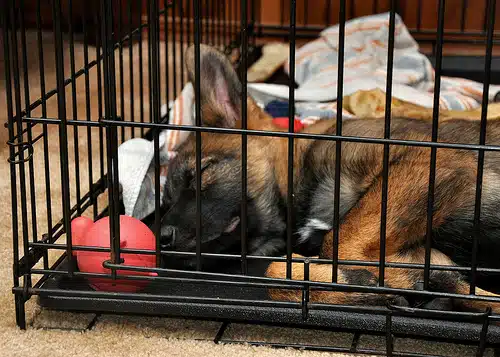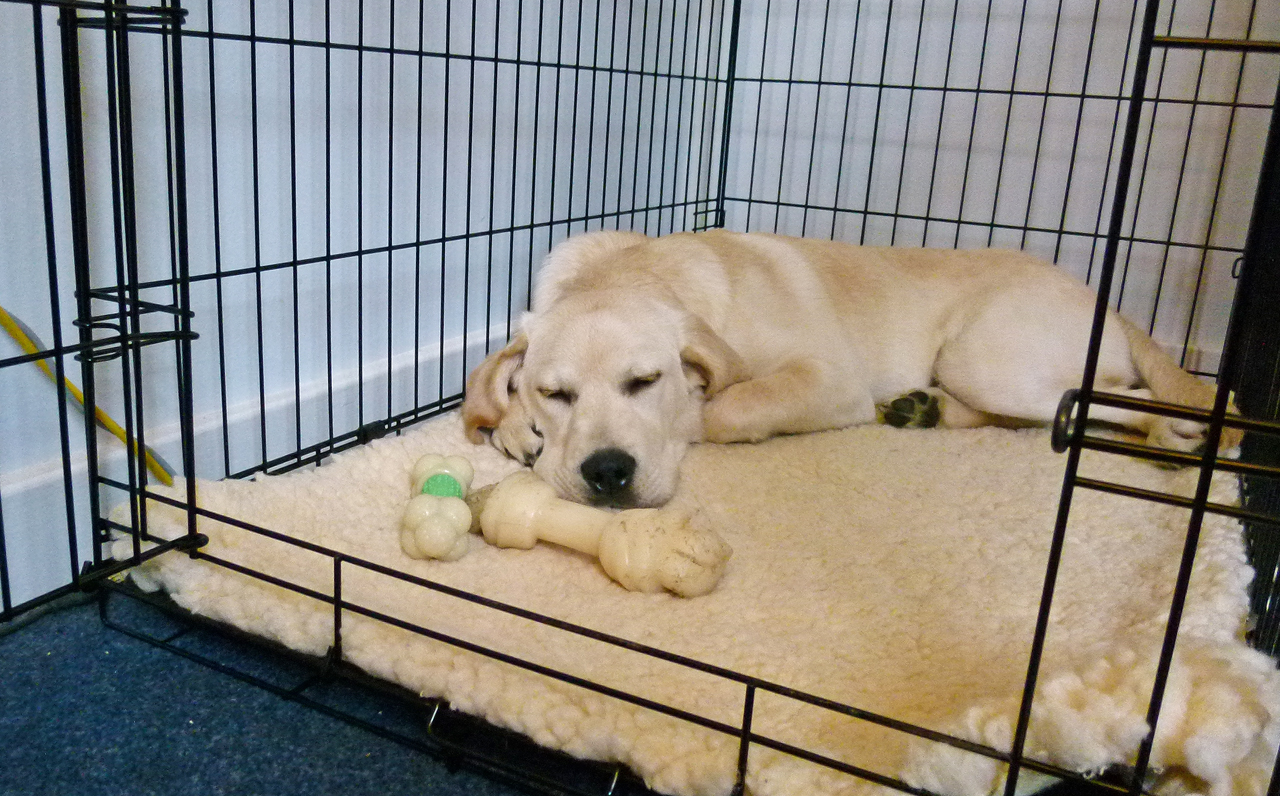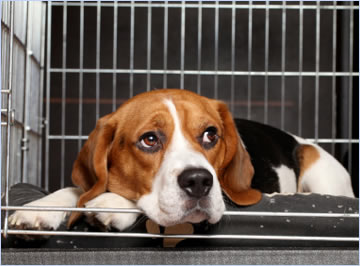Many dog owners are under the impression that kenneling their dog is a form of punishment or keeps them stir crazy. Not at all! When introduced and utilized appropriately, a dog’s crate is their safe haven.
Dogs are natural den animals; they prefer enclosed areas to nap and rest because this feels safe for them. A crate is a wonderful place to offer your dog a “den”: a quiet sanctuary for them to escape the hustle and bustle of a busy household. Kennel training is hugely helpful when training puppies and “new to the household” dogs as it plays a key factor with house training. Not only that, but a crate can actually be much safer than leaving your dog free to explore the house while you’re away as it helps prevent destructive related behaviours.
Choosing the right crate
So what does a good crate look like? There are many different types of kennels available: wire, plastic, and soft-sided material are some popular examples. Each have their pros and cons, so do some research to try to find the most suitable one for your pup. Be sure that you choose an appropriately sized crate; your dog should be able to comfortably stand, turn around, and lay on their side. You don’t want a kennel that’s too large as this can be problematic for potty training. Many crates are easily sectioned off so that you can offer your puppy the suitable space they need throughout their whole growing life without having to constantly replace kennels. Fit the bottom of the crate with a bed, a blanket or a towel to make it comfy and cozy. It’s a good idea to cover or darken the crate with a blanket or a vinyl cover as this can create a more settling environment, but be sure to keep it well ventilated.
The Do’s
- Associate with positivity: The crate is their safe place, and good things happen there! Because dogs are pack animals, try placing it in the corner of a room you often frequent; this will allow your dog to be a part of things while not getting in the way.
- Introduce slowly: It’s a learning process – it could take a few days or a few weeks. Your pup probably won’t be sold on this crate idea right away, so let them explore at their own pace. Fill the kennel with good stuff – mealtimes, treats and toys work well! When they comfortably and voluntarily go inside, then it’s time to start the next training step.
- Leave them alone: This is another adjustment phase – puppies and dogs new to kennel training can’t be left for hours at a time, so start slowly. Have your pup go inside the kennel, close the door, and wait quietly nearby for a few minutes. Leave the room for a few minutes, return and wait for a few minutes again before opening the door. Practice a few times a day, and gradually increase the time they are left alone. When your pooch is able to calmly rest in their kennel with you out of sight for thirty minutes, then you can leave them crated for short periods of time while you’re gone as well as at nighttime.
- Practice a lot: This should be a regular part of your schedule for the first few weeks you start crate training. Practice leaving your pooch alone in their kennel both when you’re at home, and for the short periods you’re away. By working on this while you’re still at home, your dog won’t associate the kennel with being alone.
- Vary your “getting ready” routine: Try kennelling your dog a few minutes (five to twenty minutes) before you actually head out. This will help practice relaxing in their crate even while something’s going on around them as well as keep them calm when you leave the house.
- Housetrain: Kennel training plays a big role with potty training as dogs don’t like to soil their den – they’d much rather do their business outside. Ergo, when they come out of their crate, take them outside and give them a chance to go potty. Give lots of praise – a treat, a short walk or a game – when they go to the bathroom in the right place. Remember that puppies have to go potty more frequently! A good rule of thumb is that puppies can hold it as many hours as they are months old plus one (a three month old can wait about four hours). They can usually be left a little bit longer (about one and half times longer) at nighttime.
The Don’t’s
- Use the crate as punishment: The crate should never be associated with fear or negativity. Remember, it’s your dog’s safe zone! It’s a place they should be happy and willing to go. There are many solutions available to prevent or manage unwanted behaviours. Seek professional assistance if you and your dog encounter challenges.
- Over kennel your dog: Don’t leave your pooch in their crate for too many hours at a time. An over kennelled dog can become depressed and anxious, and this can lead to further behavioural problems. All dogs require physical and mental exercise and stimulation as well as adequate socialization. You may have to change your schedule to attend to your dog, especially for the first few weeks after you bring a new dog into your home. Alternatively, you could hire a dog walker or pet sitter, or take them to doggie daycare.
- Consider the crate a “solution”: A crate should be used as a management tool, not as a quick fix or a problem solver. Although it’s true that kennel training virtually goes hand in hand with housetraining, this doesn’t mean that simply locking your dog in their crate will lead to an accident free household. The same is true with dogs struggling with separation anxiety and destructive habits; your dog may not have access to the rest of your home, but they could end up hurting themselves or destroying their kennel in an attempt to cope with their anxiety. If you don’t take the appropriate steps outside of kennel training, these issues won’t be resolved, and they could actually intensify.
- Respond to whining: If your pup is whining inside their kennel, the best thing you can do is ignore! Instead, wait for them to quiet down, and then the door can open. The only exception to this “whining rule” is if your dog may have to go potty. If you’re unsure, take them outside very matter of factly, and give them a minute or two to do their business. Remember, this is a trip with a purpose, not play time! If your pup doesn’t go, then it’s back in the crate for another little bit. Generally, it’s about a solid three to five minutes of quiet patience before the door opens. This rewards calm behaviour instead of those “temper tantrums”.
- Make a fuss about hellos and goodbyes: Your departure and your arrival should be neutral and uneventful. In fact, it’s best that hellos and goodbyes are virtually nonexistent. Although it’s not a guarantee, this can go a long way to help prevent separation anxiety as your return home isn’t the event your dog is counting down to all day.
With the proper introduction and dedication, a crate can be your dog’s favourite resting place. There is always a learning process, so start slowly, and practice, practice, practice! And always, if ever you encounter any difficulties, seek the appropriate guidance. Your local dog trainers are here to help! Happy training!
Image source 1: http://vomblauenhorizont.com/puppy.html
Image source 2: http://theseeingeyeinc.blogspot.ca/2011/08/crate-expectations-why-crate-training.html
Image source 3: http://www.farmandfleet.com/ask-the-experts/crate-training-your-dog/#.VHUVOjTF-uI




One Comment on “Crating your dog: jail time or sanctuary?”
I agree that people need to know that a dog’s crate is their safe haven and not a form of punishment. So many people tend to use the crate as a form of punishment for them.